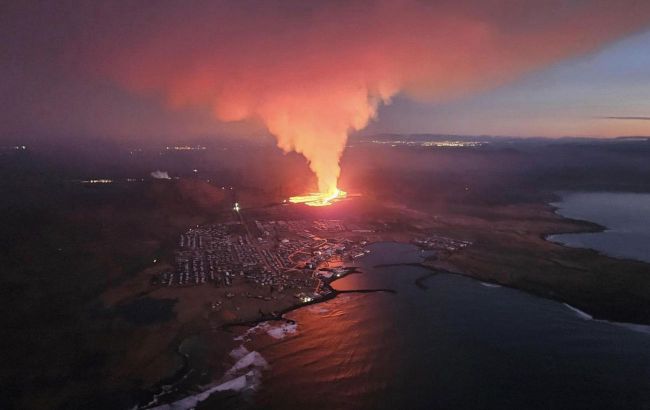Long-dormant volcano erupts in Iceland, streets on fire
 A volcano has started to erupt in Iceland (photo: Getty Images)
A volcano has started to erupt in Iceland (photo: Getty Images)
The city of Grindavik, located on the Reykjanes Peninsula in the southwest of Iceland, is on fire. The volcano's seismic activity has increased sharply over the past day and an eruption has occurred, according to The Guardian.
Two fissures opened near the city on Sunday after an increase in seismic activity prompted authorities to evacuate the population the day before.
The first eruption began at 8 a.m. when a crack opened in the ground about 450 meters from the city. Protective barriers of earth and stone forced the lava from the first crack away from the town. However, around noon, a second crack opened on the outskirts of the town, measuring about 100 meters in size by evening, and lava engulfed houses. At least three houses were engulfed in flames.
Jets of glowing orange lava flowed outward, and a huge cloud of smoke rose in the dark sky.
"In a little village like this one, we’re like a family, we all know each other as family – it’s tragic seeing this. It’s unreal, it’s like watching a film," says Sveinn Ari Gudjonsson, a 55-year-old resident who works in the fishing industry.
According to Icelandic President Gudni Johannesson, something that was hoped would not happen has happened. People's lives were not in danger, everyone was evacuated in advance. However, the infrastructure may be at risk.
Benedikt Ofeigsson from the Icelandic Meteorological Office says that the volcano "continues to surprise us."
"Things were slowing down after the eruption started, but about half an hour or an hour ago they started to pick up speed again. We are no longer seeing a slowdown in the town," he says.
The Icelandic Civil Protection Agency says it had raised its alert level to "emergency," the highest on a three-point scale, indicating that an event has begun that could cause damage to people, property, communities, or the environment.
This eruption is the fifth on the island of Reykjanes since 2021. On December 18, 2022, after several weeks of earthquakes, a powerful volcanic eruption occurred near Grindavik.
3800 residents had already been evacuated a few weeks earlier as a precautionary measure. In recent weeks, about 100 people have returned home, but on Saturday they were evacuated again.
Authorities are closely monitoring the nearby Svartsengi geothermal plant, which provides electricity and water to 30,000 residents of the Reykjanes Peninsula.
Iceland's location between the Eurasian and North American tectonic plates, which move in opposite directions, makes it a hot seismic and volcanic hotspot.
In 2010, ash clouds from the Eyjafjallajökull volcano in southern Iceland spread to much of Europe, grounding 100,000 flights and forcing hundreds of Icelanders to flee their homes.
Unlike Eyjafjallajökull, the volcanic systems of Reykjavík are not locked under glaciers and thus should not produce such ash clouds.

